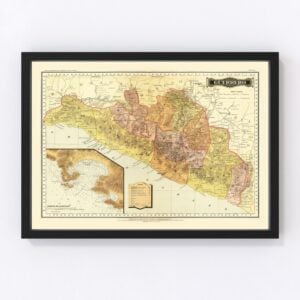Old Maps of Mexico
Take a look through our collection of Old Maps of Mexico.
Mexico is a country located in the southern part of North America. It is bordered by the United States, Guatemala, and Belize. Spanning an area of 1,972,550 square kilometers (761,610 square miles), Mexico is the 13th largest country in the world by area, and is also the 10th largest country in the world by population, holding 126,014,024 inhabitants. The country is made up of 31 different states, and some of the largest urban areas within the country are Mexico City, the capital, Monterrey, Guadalajara, Puebla, Toluca, and Tijuana. The government is known to be a federation that is representative, democratic as well as republic. The current president of Mexico is Andrés Manuel López Obrador.
Although the country is very large in land, a great majority of its land mass is incompatible with agriculture because of its aridity or soil. An estimated 59.4% of the land is agriculture, 11.8% is arable land, 1.4% holds permanent crops, 41.7% holds permanent pasture, and 33.3% is forest land. Mexico is home to two mountain ranges, which are the Sierra Madre Oreintal, and Sierra Madre Occidental, the latter being an extension of the Rocky Mountains. The highest point in the country is Pico de Orizaba, standing at an altitude of 5,700 meters, or 18,701 feet tall.Mexico is one of 17 megadiverse countries in the world. In fact, the country ranks 4th in terms of biodiversity. In fact, Mexico ranks first in the number of reptiles, with 707 known species. Along with this, there are 438 known species of mammals, 290 known species of amphibians, and 26,000 known species of plants. Many of these plants are indigenous to Mexico. Some of the country’s native culinary ingredients include maize, tomatoes, beans, squash, chocolate, vanilla, and avocados. Having such large environments can bring issues. For instance, in 2002, Mexico experienced the second fastest rate of deforestation, second to Brazil. Currently, 2,500 species are protected by legislation. There are also 170,000 square kilometers, or 65,637 miles, of protected natural areas.
In 2018, it was reported that Mexico was home to the 15th largest nominal GDP. The three main sectors of the economy are agriculture, services, and industry. Agriculture is by far the smallest employer, making up only 4% of the economy, while industry makes up 33% and services make up 63%. The economy has been known to undergo substantial growth, and it is estimated that by 2050, Mexico could possibly become the world’s fifth or seventh largest economy. Some of the main exports of the country are crude petroleum, color televisions, cars, television and radio transmitters, and trucks and vans.
Throughout the 19th and 20th centuries, population growth in Mexico was extreme. From the years 1930 to 1980, the country experienced a 3% growth rate. In 20 years, the population was able to double. The country’s life expectancy was also able to shoot up, going from 36 in 1895 to 72 in 2000.
























